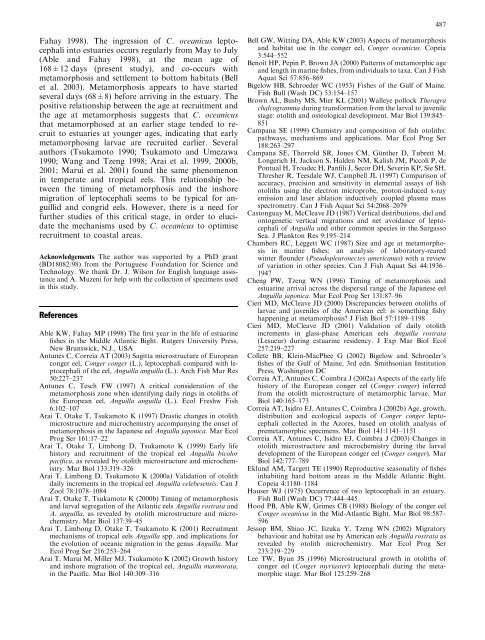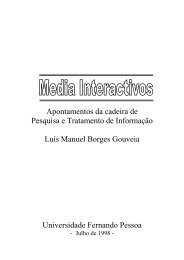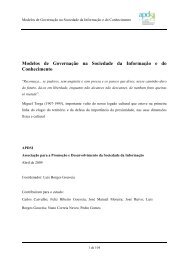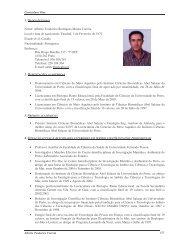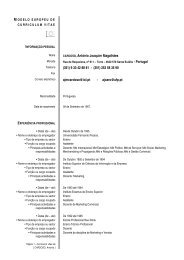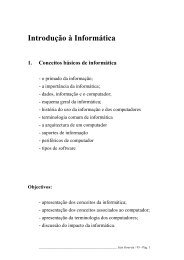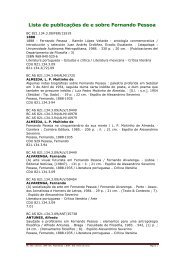Early life history of the American conger eel ... - ResearchGate
Early life history of the American conger eel ... - ResearchGate
Early life history of the American conger eel ... - ResearchGate
Create successful ePaper yourself
Turn your PDF publications into a flip-book with our unique Google optimized e-Paper software.
487Fahay 1998). The ingression <strong>of</strong> C. oceanicus leptocephaliinto estuaries occurs regularly from May to July(Able and Fahay 1998), at <strong>the</strong> mean age <strong>of</strong>168±12 days (present study), and co-occurs withmetamorphosis and settlement to bottom habitats (Bellet al. 2003). Metamorphosis appears to have startedseveral days (68±8) before arriving in <strong>the</strong> estuary. Thepositive relationship between <strong>the</strong> age at recruitment and<strong>the</strong> age at metamorphosis suggests that C. oceanicusthat metamorphosed at an earlier stage tended to recruitto estuaries at younger ages, indicating that earlymetamorphosing larvae are recruited earlier. Severalauthors (Tsukamoto 1990; Tsukamoto and Umezawa1990; Wang and Tzeng 1998; Arai et al. 1999, 2000b,2001; Marui et al. 2001) found <strong>the</strong> same phenomenonin temperate and tropical <strong>eel</strong>s. This relationship between<strong>the</strong> timing <strong>of</strong> metamorphosis and <strong>the</strong> inshoremigration <strong>of</strong> leptocephali seems to be typical for anguillidand congrid <strong>eel</strong>s. However, <strong>the</strong>re is a need forfur<strong>the</strong>r studies <strong>of</strong> this critical stage, in order to elucidate<strong>the</strong> mechanisms used by C. oceanicus to optimiserecruitment to coastal areas.Acknowledgements The author was supported by a PhD grant(BD18082/98) from <strong>the</strong> Portuguese Foundation for Science andTechnology. We thank Dr. J. Wilson for English language assistanceand A. Muzeni for help with <strong>the</strong> collection <strong>of</strong> specimens usedin this study.ReferencesAble KW, Fahay MP (1998) The first year in <strong>the</strong> <strong>life</strong> <strong>of</strong> estuarinefishes in <strong>the</strong> Middle Atlantic Bight. Rutgers University Press,New Brunswick, N.J., USAAntunes C, Correia AT (2003) Sagitta microstructure <strong>of</strong> European<strong>conger</strong> <strong>eel</strong>, Conger <strong>conger</strong> (L.), leptocephali compared with leptocephali<strong>of</strong> <strong>the</strong> <strong>eel</strong>, Anguilla anguilla (L.). Arch Fish Mar Res50:227–237Antunes C, Tesch FW (1997) A critical consideration <strong>of</strong> <strong>the</strong>metamorphosis zone when identifying daily rings in otoliths <strong>of</strong><strong>the</strong> European <strong>eel</strong>, Anguilla anguilla (L.). Ecol Freshw Fish6:102–107Arai T, Otake T, Tsukamoto K (1997) Drastic changes in otolithmicrostructure and microchemistry accompanying <strong>the</strong> onset <strong>of</strong>metamorphosis in <strong>the</strong> Japanese <strong>eel</strong> Anguilla japonica. Mar EcolProg Ser 161:17–22Arai T, Otake T, Limbong D, Tsukamoto K (1999) <strong>Early</strong> <strong>life</strong><strong>history</strong> and recruitment <strong>of</strong> <strong>the</strong> tropical <strong>eel</strong> Anguilla bicolorpacifica, as revealed by otolith microstructure and microchemistry.Mar Biol 133:319–326Arai T, Limbong D, Tsukamoto K (2000a) Validation <strong>of</strong> otolithdaily increments in <strong>the</strong> tropical <strong>eel</strong> Anguilla celebesensis. Can JZool 78:1078–1084Arai T, Otake T, Tsukamoto K (2000b) Timing <strong>of</strong> metamorphosisand larval segregation <strong>of</strong> <strong>the</strong> Atlantic <strong>eel</strong>s Anguilla rostrata andA. anguilla, as revealed by otolith microstructure and microchemistry.Mar Biol 137:39–45Arai T, Limbong D, Otake T, Tsukamoto K (2001) Recruitmentmechanisms <strong>of</strong> tropical <strong>eel</strong>s Anguilla spp. and implications for<strong>the</strong> evolution <strong>of</strong> oceanic migration in <strong>the</strong> genus Anguilla. MarEcol Prog Ser 216:253–264Arai T, Marui M, Miller MJ, Tsukamoto K (2002) Growth <strong>history</strong>and inshore migration <strong>of</strong> <strong>the</strong> tropical <strong>eel</strong>, Anguilla marmorata,in <strong>the</strong> Pacific. Mar Biol 140:309–316Bell GW, Witting DA, Able KW (2003) Aspects <strong>of</strong> metamorphosisand habitat use in <strong>the</strong> <strong>conger</strong> <strong>eel</strong>, Conger oceanicus. Copeia3:544–552Benoît HP, Pepin P, Brown JA (2000) Patterns <strong>of</strong> metamorphic ageand length in marine fishes, from individuals to taxa. Can J FishAquat Sci 57:856–869Bigelow HB, Schroeder WC (1953) Fishes <strong>of</strong> <strong>the</strong> Gulf <strong>of</strong> Maine.Fish Bull (Wash DC) 53:154–157Brown AL, Busby MS, Mier KL (2001) Walleye pollock Theragrachalcogramma during transformation from <strong>the</strong> larval to juvenilestage: otolith and osteological development. Mar Biol 139:845–851Campana SE (1999) Chemistry and composition <strong>of</strong> fish otoliths:pathways, mechanisms and applications. Mar Ecol Prog Ser188:263–297Campana SE, Thorrold SR, Jones CM, Gu¨ n<strong>the</strong>r D, Tubrett M,Longerich H, Jackson S, Halden NM, Kalish JM, Piccoli P, dePontual H, Troadec H, Panfili J, Secor DH, Severin KP, Sie SH,Thresher R, Teesdale WJ, Campbell JL (1997) Comparison <strong>of</strong>accuracy, precision and sensitivity in elemental assays <strong>of</strong> fishotoliths using <strong>the</strong> electron microprobe, proton-induced x-rayemission and laser ablation inductively coupled plasma massspectrometry. Can J Fish Aquat Sci 54:2068–2079Castonguay M, McCleave JD (1987) Vertical distributions, diel andontogenetic vertical migrations and net avoidance <strong>of</strong> leptocephali<strong>of</strong> Anguilla and o<strong>the</strong>r common species in <strong>the</strong> SargassoSea. J Plankton Res 9:195–214Chambers RC, Leggett WC (1987) Size and age at metamorphosisin marine fishes: an analysis <strong>of</strong> laboratory-rearedwinter flounder (Pseudopleuronectes americanus) with a review<strong>of</strong> variation in o<strong>the</strong>r species. Can J Fish Aquat Sci 44:1936–1947Cheng PW, Tzeng WN (1996) Timing <strong>of</strong> metamorphosis andestuarine arrival across <strong>the</strong> dispersal range <strong>of</strong> <strong>the</strong> Japanese <strong>eel</strong>Anguilla japonica. Mar Ecol Prog Ser 131:87–96Cieri MD, McCleave JD (2000) Discrepancies between otoliths <strong>of</strong>larvae and juveniles <strong>of</strong> <strong>the</strong> <strong>American</strong> <strong>eel</strong>: is something fishyhappening at metamorphosis? J Fish Biol 57:1189–1198Cieri MD, McCleave JD (2001) Validation <strong>of</strong> daily otolithincrements in glass-phase <strong>American</strong> <strong>eel</strong>s Anguilla rostrata(Lesueur) during estuarine residency. J Exp Mar Biol Ecol257:219–227Collete BB, Klein-MacPhee G (2002) Bigelow and Schroeder’sfishes <strong>of</strong> <strong>the</strong> Gulf <strong>of</strong> Maine, 3rd edn. Smithsonian InstitutionPress, Washington DCCorreia AT, Antunes C, Coimbra J (2002a) Aspects <strong>of</strong> <strong>the</strong> early <strong>life</strong><strong>history</strong> <strong>of</strong> <strong>the</strong> European <strong>conger</strong> <strong>eel</strong> (Conger <strong>conger</strong>) inferredfrom <strong>the</strong> otolith microstructure <strong>of</strong> metamorphic larvae. MarBiol 140:165–173Correia AT, Isidro EJ, Antunes C, Coimbra J (2002b) Age, growth,distribution and ecological aspects <strong>of</strong> Conger <strong>conger</strong> leptocephalicollected in <strong>the</strong> Azores, based on otolith analysis <strong>of</strong>premetamorphic specimens. Mar Biol 141:1141–1151Correia AT, Antunes C, Isidro EJ, Coimbra J (2003) Changes inotolith microstructure and microchemistry during <strong>the</strong> larvaldevelopment <strong>of</strong> <strong>the</strong> European <strong>conger</strong> <strong>eel</strong> (Conger <strong>conger</strong>). MarBiol 142:777–789Eklund AM, Targett TE (1990) Reproductive seasonality <strong>of</strong> fishesinhabiting hard bottom areas in <strong>the</strong> Middle Atlantic Bight.Copeia 4:1180–1184Hauser WJ (1975) Occurrence <strong>of</strong> two leptocephali in an estuary.Fish Bull (Wash DC) 77:444–445Hood PB, Able KW, Grimes CB (1988) Biology <strong>of</strong> <strong>the</strong> <strong>conger</strong> <strong>eel</strong>Conger oceanicus in <strong>the</strong> Mid-Atlantic Bight. Mar Biol 98:587–596Jessop BM, Shiao JC, Iizuka Y, Tzeng WN (2002) Migratorybehaviour and habitat use by <strong>American</strong> <strong>eel</strong>s Anguilla rostrata asrevealed by otolith microchemistry. Mar Ecol Prog Ser233:219–229Lee TW, Byun JS (1996) Microstructural growth in otoliths <strong>of</strong><strong>conger</strong> <strong>eel</strong> (Conger myriaster) leptocephali during <strong>the</strong> metamorphicstage. Mar Biol 125:259–268


